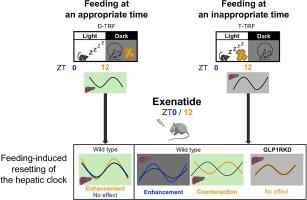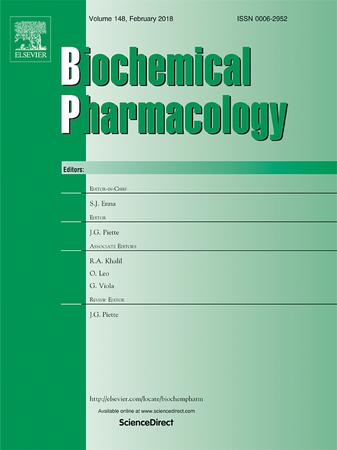艾塞那肽通过中枢神经系统中的胰高血糖素样肽-1受体对肝脏昼夜节律产生时间依赖性影响。
IF 5.3
2区 医学
Q1 PHARMACOLOGY & PHARMACY
引用次数: 0
摘要
越来越多的证据表明,昼夜节律紊乱会导致与生活方式有关的疾病的发生。我们之前已经证明,胰高血糖素样肽-1(GLP-1)受体激动剂艾塞那肽能强烈影响外周组织的分子时钟。本研究旨在探讨艾塞那肽给药时间和中枢神经系统特异性 GLP-1 受体敲除(GLP1RKD)对小鼠肝脏时钟的影响。雄性C57BL/6J和GLP1RKD小鼠的饲养周期为12小时/12小时光/暗循环,喂食时间限制在光照期(L-TRF)或黑暗期的前4小时(D-TRF)。与此同时,在黑暗期(ZT 12)或光照期(ZT 0)开始时,每天一次给予4-5次艾塞那肽,之后我们评估肝脏中时钟基因的mRNA表达节律。在ZT 12给药的艾塞那肽抵消了L-TRF对野生型小鼠肝脏时钟的相移效应,而在ZT 0给药的艾塞那肽则增强了其效应。然而,无论给药时间长短,艾塞那肽都不会影响D-TRF下肝脏时钟的相位。艾塞那肽对野生型小鼠的作用在 GLP1RKD 小鼠中减弱。这些结果表明,艾塞那肽通过中枢GLP-1系统对肝脏昼夜节律产生时间依赖性影响。在活动期开始时(即人类的早晨)服用艾塞那肽可能会防止不规律饮食习惯导致的外周时钟紊乱。本文章由计算机程序翻译,如有差异,请以英文原文为准。

Exenatide administration time-dependently affects the hepatic circadian clock through glucagon-like peptide-1 receptors in the central nervous system
Accumulating evidence indicates that disruption of the circadian clock contributes to the development of lifestyle-related diseases. We have previously shown that exenatide, a glucagon-like peptide-1 (GLP-1) receptor agonist, can strongly affect the molecular clocks in the peripheral tissues. This study aimed to investigate the effects of its dosing time and the central nervous system-specific GLP-1 receptor knockdown (GLP1RKD) on the hepatic clock in mice treated with exenatide. Male C57BL/6J and GLP1RKD mice were housed under a 12-h/12-h light/dark cycle, and feeding was restricted to either the light period (L-TRF) or the first 4 h in the dark period (D-TRF). In parallel, exenatide was administered 4–5 times, once daily either at the beginning of the dark (ZT 12) or light period (ZT 0), and we assessed the mRNA expression rhythms of clock genes in the liver thereafter. Exenatide administration at ZT 12 counteracted the phase shift effect of the L-TRF on the hepatic clock of wild-type mice, whereas the dosing at ZT 0 enhanced its effect. However, exenatide did not influence the phase of the hepatic clock under D-TRF regardless of the dosing time. The effect of exenatide in wild-type mice weakened in GLP1RKD mice. These results showed that exenatide dosing time-dependently affects the hepatic circadian clock through the central GLP-1 system. Exenatide administration at the beginning of the active period (i.e., in the morning for humans) might prevent disruption of the peripheral clocks caused by irregular eating habits.
求助全文
通过发布文献求助,成功后即可免费获取论文全文。
去求助
来源期刊

Biochemical pharmacology
医学-药学
CiteScore
10.30
自引率
1.70%
发文量
420
审稿时长
17 days
期刊介绍:
Biochemical Pharmacology publishes original research findings, Commentaries and review articles related to the elucidation of cellular and tissue function(s) at the biochemical and molecular levels, the modification of cellular phenotype(s) by genetic, transcriptional/translational or drug/compound-induced modifications, as well as the pharmacodynamics and pharmacokinetics of xenobiotics and drugs, the latter including both small molecules and biologics.
The journal''s target audience includes scientists engaged in the identification and study of the mechanisms of action of xenobiotics, biologics and drugs and in the drug discovery and development process.
All areas of cellular biology and cellular, tissue/organ and whole animal pharmacology fall within the scope of the journal. Drug classes covered include anti-infectives, anti-inflammatory agents, chemotherapeutics, cardiovascular, endocrinological, immunological, metabolic, neurological and psychiatric drugs, as well as research on drug metabolism and kinetics. While medicinal chemistry is a topic of complimentary interest, manuscripts in this area must contain sufficient biological data to characterize pharmacologically the compounds reported. Submissions describing work focused predominately on chemical synthesis and molecular modeling will not be considered for review.
While particular emphasis is placed on reporting the results of molecular and biochemical studies, research involving the use of tissue and animal models of human pathophysiology and toxicology is of interest to the extent that it helps define drug mechanisms of action, safety and efficacy.
 求助内容:
求助内容: 应助结果提醒方式:
应助结果提醒方式:


